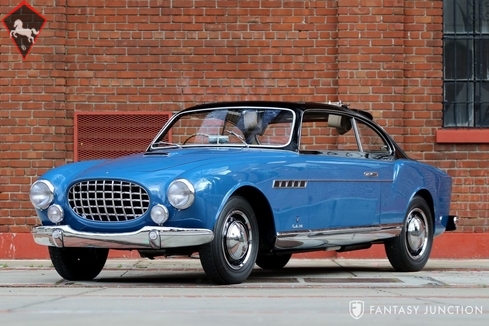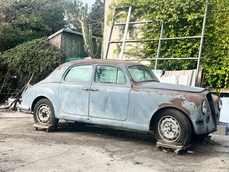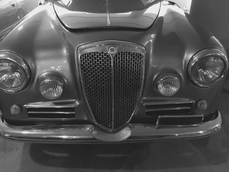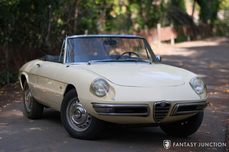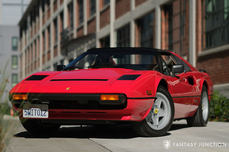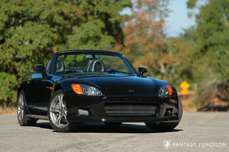Lancia Aurelia B10/21/22/12 2 Liter V6 1952
General description :
1952 Lancia Aurelia B52 Vignale Coupe
s/n B52-1026, Engine no. 3113
Blue and Black with Tan Leather
Among the most prestigious and technically advanced Italian car companies, Lancia has a robust history of crafting competition winners, innovative engineering, and building wonderful high quality touring cars. Rarely does a single car company excel so completely in so many areas of motoring. During their premier sports and touring car years, the Aurelia was developed as a successor to the Aprilia. Unveiled at the 1950 Turn Motor Show, the Aurelia bristled with technologically advanced features, including the world’s first production V6, rear mounted transaxle, and inboard rear brakes. The Aurelia evolved by 1952 with an increase in wheelbase to 2860mm coupled with a displacement increase of the extraordinary engine to 2.0 liters. Typical for the era, the B52 chassis was constructed with coachbuilding in mind, and arranged for body development with some of the greatest Italian coachbuilders. Aurelia B52 production would run only a brief period, from 1952 through 1953, culminating in a total of only 98 cars built with the B52 designation. Vignale constructed a mere five examples, each of which slightly varies in coachwork and trim details. Of these five examples, only two were coupes.
This particular car, chassis number B52-1026, was completed at the Lancia factory and dispatched to Carrozzeria Vignale where the exceptional Michelotti body design was executed on special order from Count Christian Orssich de Slavetich, a close friend of King Peter II of Yugoslavia. Having spent much of his time in Switzerland, the Count subsequently registered the car in Zurich on August 17, 1954. Records of previous sales indicate the car was sold in 1960, and from 1973 to 1985, the car is reported to have belonged to a mechanic in the Swiss canton of Zug. During the early 1990s, the car was treated to a comprehensive restoration at the hands of experts at KCA in Milan, Italy. Upon completion, the car went on to win several awards including a class win at the 1995 Pebble Beach Concours d’Elegance. Shortly after, this stunning Lancia became part of the prestigious Blackhawk Collection where it remained until 2012, when it was purchased by a Swiss collector and shipped back to its former home in Switzerland. Equipped with the rare and desirable Nardi performance kit (beautiful wood steering wheel, unique air cleaner, and twin Solex carburetors), this exceptional example received more than 22,000 Swiss francs of mechanical work by Graber Sportgarage, with attention to mechanical performance that included a new clutch, thorough fuel system overhaul including restored tank, and significant brake work, all of which is supported by photographic documentation and copies of receipts for recent work.
Today, this exceptionally rare Lancia is beautifully finished with remarkable Vignale coachwork, featuring a stunning full-length retractable roof and gorgeous two-tone paint. Offering all the beauty and grace of a touring car coupled with the exhilaration of open motoring, the elegant two-tone paint beautifully highlights the classically inspired fender line as it gracefully dips just aft of the B pillar, enhancing the expansive side glass. The high gloss paint is of exceptional quality throughout the entire car, showing only mild evidence of mellowing. The older restoration still retains a fine finish throughout the exterior with superbly detailed trim, emblems, and carefully finished details. The doorjambs and other inner body surfaces display excellent paint and detailing, and the rubber, weather stripping, and trim are all properly finished. All panels open and shut as expected, displaying consistent dimensions and fit, with crisp door closures, excellent hood fit, and proper part lines. There are no major flaws to detract significantly from the car’s visual presentation either in the finish or various plated parts. The chrome is very good to excellent condition showing only mild mellowing, while the lights, lenses, and glass are in excellent condition with good gloss, clarity, and coloring. The exterior window garnish and retractable roof material are all in excellent condition. The correct and beautifully finished details such as the taillights, hidden door handles, and side vents are very nicely presented. The cleanly delineated wheels and wheel covers show no significant marks, shod with appropriately sized and period correct Michelin X tires.
The interior is sumptuously presented, featuring a perfect blend of rich leather, body color paint on the dashboard, and contrasting carpet. The leather color is an elegant and sporting accent to the vivid exterior colors, with pleated seats, map pockets stitched into the door panels, and soft wool broadcloth headliner creating a warm, inviting presence. The dashboard is beautifully arrayed with jewelry-like instruments displaying excellent color and dimensional numeric indication. A fine aluminum trim line with Vignale’s trademark detailed etching delineates the blue and black paint separation. Details delight the eye everywhere, even in the smallest handle, trim piece, or emblem. The polished aluminum and wood Nardi steering wheel, radio, and wonderfully preserved knobs and switches handsomely complete the refined look and feel of this exemplary interior. Rear passenger seating, almost always a shelf or dismissive tray relegated to children scale, is surprisingly comfortable and spacious, especially with added headroom due to the trim headliner afforded by the soft roof.
The engine compartment and technically-advanced matching numbers 2.0 liter V6 engine still retain a wonderfully finished look and feel despite the time that has elapsed since the award winning restoration was completed. The correct Nardi twin carburetor intake and air cleaner have been restored utilizing correct finishes and appropriate fittings, original components linkages, hoses and wiring to create a very cohesive and correct overall presentation. The black wrinkle finish and Lancia script on the heads, correct radiator, proper water inlet pipe and thermostatically controlled radiator blinds, and numerous other details are all correctly finished, warmly hued by gentle use over the past few years. Correctly restored and properly documented, the engine compartment is a fine tribute to both innovative Lancia engineering and quality, as well as contemporary top-level restoration.
The trunk features proper finishes and materials, reflective of original specifications, housing a spare tire and fuel fille. Even with the spare tire in place, the trunk is quite capacious and would easily allow for luggage and soft travel bags suitable for motoring events. The undercarriage is clean and solid, displaying only mildly settled finishes reflective of the restoration that has previously brought concours victories to this finely presented car.
The car starts easily, revs responsively, and runs smoothly at idle delivering a pleasing and surprisingly sporty exhaust note. Seating position and controls feel very comfortable and visibility is quite good due to the delicate pillars and large side glass. On the road, this Lancia performs with ease and grace, making smooth progressive power while delivering a comforting ride, and spirited acceleration, assisted by the additional Nardi engine equipment. It has an exceptionally crisp engine with an unusually responsive character. Pulling back the full-length fabric sunroof, and lowering the side glass, open motoring becomes all the more exhilarating without significant wind buffeting even at higher speeds. The brakes perform in keeping with cars of this vintage pulling down smoothly and evenly as pressure is applied on the firm, high pedal. The car has an unusually good transaxle, with smooth, precise shifts and a wonderful, high quality feel that reminds the driver why Lancias of this era are so incomparable. Handling is certainly more in the touring class, it is very reflective of Lancia engineering excellence and performance that has contributed to so many of their competition successes. The structural integrity of the car is very sound throughout the floor and substructure, further supported by the ongoing mechanical service and detailing more recently performed. The car is offered with an owner’s manual, two sets of keys, and various service records dating from 2014 and 2017.
With stunning Vignale coachwork, beautifully executed Michelotti design, and Nardi performance, this handsomely restored Lancia B52 Aurelia combines superb driving pleasure and stunning visual excellence in delightful and exceptionally rare coachbuilt car. Having not been shown at concours shows for more than a decade, the new owner may also enjoy participation at Pebble Beach, Villa d’Este, Amelia Island, and other top level vintage and classic automobile events.
https://fantasyjunction.com/inventory/1952-lancia-aurelia-b52-vignale-coupe/overview
1952 Lancia Aurelia B10/21/22/12 2 Liter V6 is listed sold on ClassicDigest in Emeryville by Fantasy Junction for $425000.
Car Facts
Car type : Car Make : Lancia Model : Aurelia B10/21/22/12 Model Version : 2 Liter V6 Engine size : 0.0 Model Year : 1952 Location : Emeryville Vehicle Registration : Normal
Sold
Seller Information
Sold
People who viewed this Lancia Aurelia B10/21/22/12 also viewed similar Lancia listed at ClassicDigest
Other cars listed for sale by this dealer
About Lancia
Ah, Lancia, the Italian marque that danced on the edge of automotive brilliance! Let me take you on a journey through the captivating story of Lancia, a brand that embodies passion, innovation, and rallying prowess.Act 1: The Early Years (1906-1920s)
Lancia was founded in 1906 by Vincenzo Lancia, an engineering wizard with a flair for the extraordinary. The brand quickly gained a reputation for its precision engineering and innovative approach. The Lancia Alpha, introduced in 1907, was the first car to feature a narrow-angle V4 engine, setting the tone for Lancia's commitment to technical excellence.
Act 2: Innovation at its Core (1930s-1950s)
The 1930s saw Lancia pushing the boundaries of innovation with models like the Lambda, the first car to feature a load-bearing monocoque chassis. The Aprilia, introduced in the 1930s, showcased cutting-edge aerodynamics and a V4 engine, solidifying Lancia's reputation as a pioneer.
Act 3: Post-War Elegance (1950s-1960s)
After World War II, Lancia continued to dazzle with models like the Aurelia, the first production car to feature a V6 engine. It blended performance with comfort and elegance. The Flaminia followed, embodying luxury and advanced engineering.
Act 4: Rally Domination (1970s-1980s)
Lancia etched its name in motorsport history with an unparalleled rally legacy. The Lancia Stratos, a wedge-shaped wonder, dominated the rally scene in the 1970s, clinching three consecutive World Rally Championships from 1974 to 1976. The Delta Integrale, introduced in the 1980s, continued this rally reign with multiple championships.
Act 5: Struggles and Resilience (1990s-2000s)
The latter part of the 20th century brought financial challenges for Lancia, leading to collaborations with other automakers. Despite the difficulties, Lancia introduced models like the Thesis and the Ypsilon, showcasing its commitment to style and substance.
Act 6: 21st Century Reinvention (2010s-Present)
In the 2010s, Lancia faced a shift in strategy, focusing on the Ypsilon as its primary model. While production numbers dwindled, the brand maintained its reputation for distinctive design and comfort.
Epilogue: A Legacy of Passion and Innovation
Lancia's story is one of passion, innovation, and motorsport glory. The brand, with its groundbreaking designs, technological advancements, and rallying triumphs, has left an indelible mark on the automotive world. Lancia may have faced challenges in recent years, but its legacy lives on, celebrated by enthusiasts who recognize the magic woven into each Lancia creation. Finally, Here are some of the most important Lancia models that have left an enduring mark:
1. Lancia Lambda (1922-1931):
The Lancia Lambda is often considered a pioneering model, being the first car to feature a load-bearing monocoque chassis. This innovation set the stage for modern automotive design. The Lambda was available in various body styles and showcased Lancia's commitment to engineering excellence.
2. Lancia Aurelia (1950-1958):
The Aurelia, introduced in the early 1950s, was a groundbreaking model for Lancia. It was the first production car to feature a V6 engine, and it incorporated advanced engineering, including a rear transaxle and inboard rear brakes. The Aurelia set new standards for performance and comfort.
3. Lancia Flaminia (1957-1970):
Continuing Lancia's tradition of combining style with innovation, the Flaminia was introduced as a luxury sedan. It featured a V6 engine, a de Dion rear suspension, and avant-garde styling. The Flaminia further solidified Lancia's reputation for producing high-end, technically advanced vehicles.
4. Lancia Stratos (1973-1978):
The Lancia Stratos is an icon in the world of rallying. Born out of Lancia's rallying ambitions, the Stratos was purpose-built for competition. With its distinctive wedge-shaped design and a mid-mounted V6 engine, it became the first car to win the World Rally Championship three times consecutively from 1974 to 1976.
5. Lancia Delta (1979-1994):
The Lancia Delta is synonymous with rally success. It dominated the rally scene in the late '80s and early '90s, winning six consecutive manufacturers' titles in the World Rally Championship. The Delta's combination of performance, agility, and versatility made it an icon both on and off the rally stages.
6. Lancia Thema 8.32 (1986-1994):
The Lancia Thema 8.32 was a performance-oriented version of the Thema sedan, and it stood out for its collaboration with Ferrari. It featured a 3.0-liter V8 engine sourced from Ferrari, making it one of the few sedans with a Ferrari powerplant. This model showcased Lancia's ability to blend luxury and performance.
